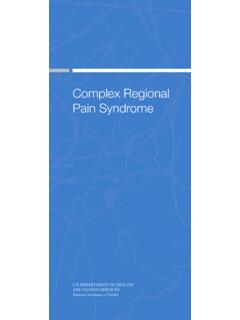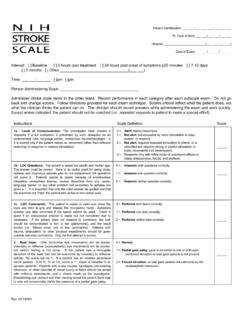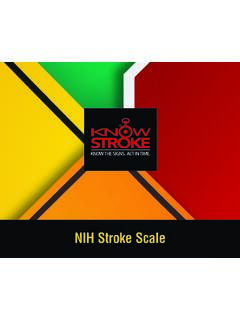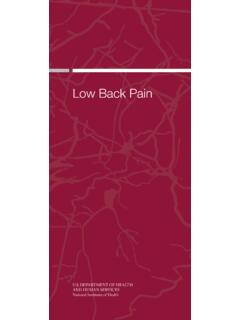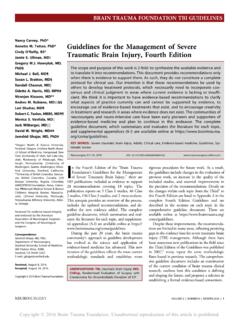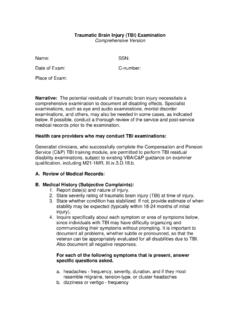Transcription of Traumatic Brain Injury - National Institute of ...
1 Traumatic Brain InjuryHope Through ResearchNational Institute of Neurological Disorders and StrokeNational Institutes of HealthNINDS health-related material is provided for information purposes only and does not necessarily represent endorsement by or an official position of the National Institute of Neurological Disorders and Stroke or any other Federal agency. Advice on the treatment or care of an individual patient should be obtained through consultation with a physician who has examined that patient or is familiar with that patient s medical history. All NINDS-prepared information is in the public domain and may be freely copied. Credit to the NINDS or the NIH is ..Table of ContentsWhat is a TBI? 1 What are the signs and symptoms? 2 TBI in children3 Effects on consciousness 4 How does TBI affect the Brain ? 5 What are the leading causes of TBI? 9 How is TBI diagnosed? 11 How is TBI treated? 13 Treating mild to moderate TBI 14 Treating severe TBI 15 Rehabilitation 16 Other factors that influence recovery 17 Genes17 Age 18 Can a TBI be prevented?
2 18 What research is NINDS funding? 20 Clinical trials 22 Interagency and International Research Collaboration 23 How can I support TBI research? 24 Where can I get more information? 251 What is a TBI? A Traumatic Brain Injury (TBI) can be caused by a forceful bump, blow, or jolt to the head or body, or from an object that pierces the skull and enters the Brain . Not all blows or jolts to the head result in a TBI. Some types of TBI can cause temporary or short-term problems with normal Brain function, including problems with how the person thinks, understands, moves, communicates, and acts. More serious TBI can lead to severe and permanent disability, and even injuries are considered primary, meaning the damage is immediate. Other outcomes of TBI can be secondary, meaning they can occur gradually over the course of hours, days, or appear weeks later. These secondary Brain injuries are the result of reactive processes that occur after the initial head trauma.
3 There are two broad types of head injuries: penetrating and non-penetrating. Penetrating TBI (also known as open TBI) happens when an object pierces the skull (for example, a bullet, shrapnel, bone fragment, or by a weapon such as hammer or knife) and enters the Brain tissue. Penetrating TBI typically damages only part of the Brain . Non-penetrating TBI (also known as closed head Injury or blunt TBI) is caused by an external force strong enough to move the Brain within the skull. Causes include falls, motor vehicle crashes, sports injuries, blast Injury , or being struck by an object. Some accidents such as explosions, natural disasters, or other extreme events can cause both penetrating and non- penetrating TBI in the same are the signs and symptoms? Seek immediate medical attention if you experience any of the following physical, cognitive/behavioral, or sensory symptoms, especially within the first 24 hours after a TBI:Physical headache convulsions or seizures blurred or double vision unequal eye pupil size or dilation clear fluids draining from the nose or ears nausea and vomiting new neurologic deficit, , slurred speech; weakness of arms, legs, or face; loss of balanceCognitive/behavioral loss of or change in consciousness anywhere from a few seconds to a few hours decreased level of consciousness, , hard to awaken mild to profound confusion or disorientation problems remembering, concentrating, or making decisions changes in sleep patterns ( , sleeping more, difficulty falling or staying asleep).
4 Inability to waken from sleep frustration, irritabilityPerception/sensation light-headedness, dizziness, vertigo, or loss of balance or coordination3 blurred vision hearing problems, such as ringing in the ears bad taste in the mouth sensitivity to light or sound mood changes or swings, agitation, combativeness, or other unusual behavior feeling anxious or depressed fatigue or drowsiness; a lack of energy or motivationHeadache, dizziness, confusion, and fatigue tend to start immediately after an Injury , but resolve over time. Emotional symptoms such as frustration and irritability tend to develop during in childrenChildren might be unable to let others know that they feel different following a blow to the head. A child with a TBI may display the following signs or symptoms: changes in eating or nursing habits persistent crying, irritability, or crankiness; inability to be consoled changes in ability to pay attention lack of interest in a favorite toy or activity changes in sleep patterns seizures sadness or depression loss of a skill, such as toilet training loss of balance or unsteady walking vomiting4 TBI symptoms including headache, dizziness, confusion, and fatigue tend to start immediately after an Injury , but resolve over on consciousnessA TBI can cause problems with consciousness, awareness, alertness, and responsiveness.
5 Generally, there are four abnormal states that can result from a severe TBI: Minimally conscious state People with severely altered consciousness who still display some evidence of self-awareness or awareness of one s environment (such as following simple commands, yes/no responses). Vegetative state A result of widespread damage to the Brain , people in a vegetative state are unconscious and unaware of their surroundings. However, they can have periods of unresponsive alertness and may groan, move, or show reflex responses. If this state lasts longer than a few weeks, it is referred to as a persistent vegetative state. Coma A person in a coma is unconscious, unaware, and unable to respond to external stimuli 5such as pain or light. Coma generally lasts a few days or weeks after which the person may regain consciousness, die, or move into a vegetative state. Brain death The lack of measurable Brain function and activity after an extended period of time is called Brain death and may be confirmed by studies that show no blood flow to the Brain .
6 How does TBI affect the Brain ? TBI-related damage can be confined to one area of the Brain , known as a focal Injury , or it can occur over a more widespread area, known as a diffuse Injury . The type of Injury also affects how the Brain is damaged. Primary effects on the Brain include various types of bleeding and tearing forces that injure nerve fibers and cause inflammation, metabolic changes, and Brain swelling. Diffuse axonal Injury (DAI) one of the most common types of Brain injuries refers to widespread damage to the Brain s white matter. White matter is composed of bundles of axons (the projections of nerve cells that carry electrical impulses and connect various areas of the Brain to one another). DAI usually results from rotational forces (twisting) or sudden forceful stopping that stretches or tears these axon bundles. This damage commonly occurs in auto accidents, falls, or sports injuries. DAI can disrupt and break down communication among nerve cells (neurons) in the Brain .
7 It also leads to the release of Brain chemicals that can cause further damage. Brain damage may be temporary or permanent and recovery can be Concussion a type of mild TBI that may be considered a temporary Injury to the Brain but could take minutes to several months to heal. Concussion can be caused by a number of things including a bump, blow, or jolt to the head, sports Injury or fall, motor vehicle accident, weapons blast, or a rapid acceleration or deceleration of the Brain within the skull (such as the person having been violently shaken). The individual either suddenly loses consciousness or has sudden altered state of consciousness or awareness. A second concussion closely following the first one causes further damage to the Brain the so-called second hit phenomenon and can lead to permanent damage or even death in some instances. Post-concussion syndrome involves symptoms that last for weeks or longer following concussion.
8 Hematomas bleeding in and around the Brain caused by a rupture to a blood vessel. Different types of hematomas form depending on where the blood collects relative to the meninges, the protective membranes surrounding the Brain , which consist of three layers: dura mater (outermost), arachnoid mater (middle), and pia mater (innermost). Epidural hematomas involve bleeding into the area between the skull and the dura mater. These can occur within minutes to hours after damage to a Brain vessel under the skull and are particularly dangerous. Subdural hematomas involve bleeding between the dura and the arachnoid mater, and, like epidural hematomas, exert pressure on the outside of the Brain . They are very common in the elderly after a Subarachnoid hemorrhage is bleeding between the arachnoid mater and the pia mater. Bleeding into the Brain itself is called an intracerebral hematoma and damages the surrounding tissue. Contusions a bruising or swelling of the Brain that occurs when very small blood vessels bleed into Brain tissue.
9 Contusions can occur directly under the impact site ( , a coup Injury ) or, more often, on the complete opposite side of the Brain from the impact ( , a contrecoup Injury ). They can appear after a delay of hours to a day. Coup and contrecoup lesions generally occur when the head abruptly decelerates, which causes the Brain to bounce back and forth within the skull (such as in a high-speed car crash or in shaken baby syndrome). Skull fractures breaks or cracks in one or more of the bones that form the skull. They are a result of blunt force trauma and can cause damage to the membranes, blood vessels, and Brain under the fracture. One main benefit of helmets is to prevent skull fracture. Chronic Traumatic encephalopathy (CTE) is a progressive neurological disorder associated with symptoms that may include problems with thinking, understanding, and communicating; motor disorders (affecting movement); problems with impulse control and depression; confusion; and irritability.
10 CTE occurs in those with extraordinary exposure to multiple Skull fractures result from blunt force trauma and can cause damage to underlying areas of the to the head and as a delayed consequence after many years. Studies of retired boxers have shown that repeated blows to the head can cause issues including memory problems, tremors, and lack of coordination and dementia. Recent studies have demonstrated rare cases of CTE in other sports with repetitive mild head impacts ( , soccer, wrestling, football, and rugby). A single, severe TBI also may lead to a disorder called post- Traumatic dementia (PTD), which may be progressive and share some features with CTE. Studies assessing patterns among large populations of people with TBI indicate that moderate or severe TBI in early or mid-life may be associated with increased risk of dementia later in damage can include: Hemorrhagic progression of a contusion (HPC) injuries occur when an initial contusion from the primary Injury continues to bleed in and around the Brain and expand over time.
